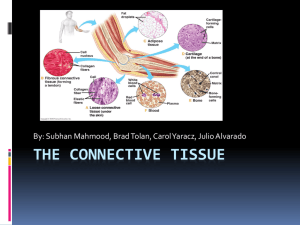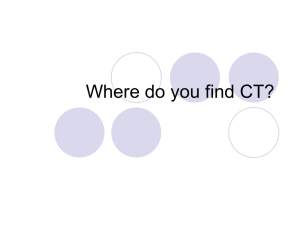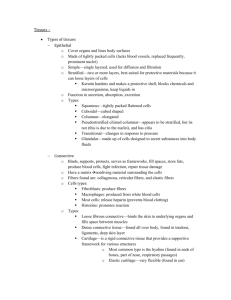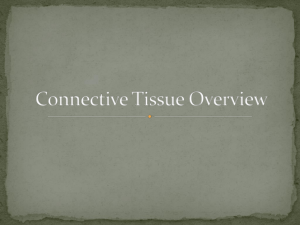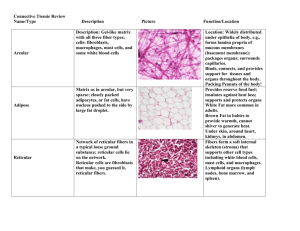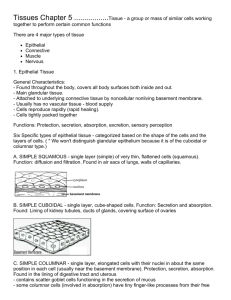Connective Tissue
advertisement
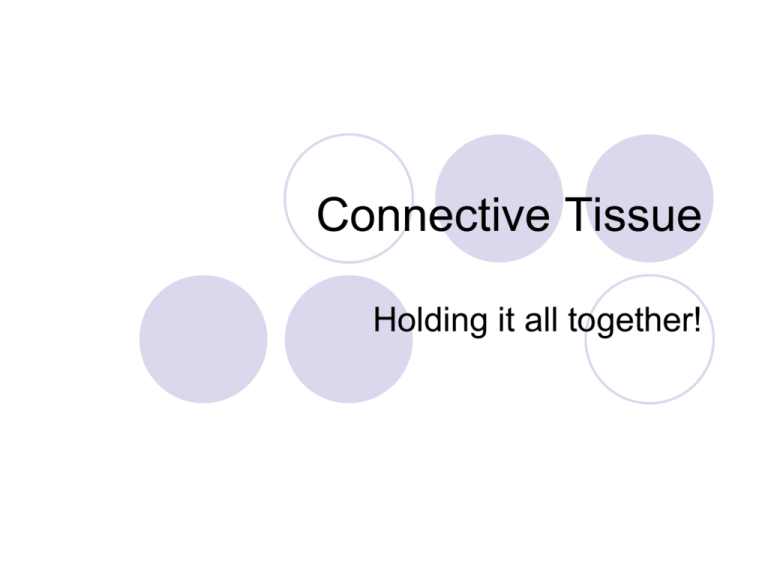
Connective Tissue Holding it all together! Connective tissue is found everywhere! Main classes/types: 1. Connective tissue proper 2. Cartilage 3. Bone 4. Blood Properties 1. common origin Mesenchyme 2. degrees of vascularity 3. great degree of “non-living” extracellular matrix Connective Tissue Binds structures Provides support and protection Serve as frameworks, fill spaces, store fat, produce blood cells, protect against infection, repair damaged tissue Abundance of matrix btw cells Blood supply varies. Structural elements: Ground substance (matrix) Fibers Cells Wide range of varying tissue! Different structuresdifferent functions! Ground Substance Unstructured material Fills spaces/contains fibers Composed of: interstitial fluid cell adhesion proteins glue like function Proteoglycansprotein core (point of attachment) “GAGs” (interlock trapping water) Major Cell Types: Blasts vs. Cytes 1. Blast Cells Fibroblasts- large star shaped cells that produce fibers by secreting proteins into the matrix of CT tissue. Chondroblast – build cartilage tissue Osteoblast – build osseous (bone tissue) Blasts build!!!!! More Cells Fat Cells/Adipocytes – store energy/nutrients White Blood Cells – respond to injury and infection to protect and heal the tissue Mast Cells – stick around blood vessels, detect foreign microorganisms and start the inflammatory response against them. Macrophages – “big eaters” phagocytize lots of foreign material, from bacteria, to old cells, proteins, and dust. Fibroblast—laying matrix CONNECTIVE TISSUE-FIBER TYPES A. Collagenous fibers- Thick threads of protein (collagen) Grouped in long parallel bundles, they are flexible, but only slightly elastic. Great tensile strength (ligaments and tendons) B. Elastic fibersComposed of protein elastin These fibers branch, forming complex networks. (weaker than collagenous fiber, however they stretch and can return back to there shape.) Elastic Fibers C. Reticular Fibers Very thin collagenous fibers Highly branched, form supporting networks (LIKE A NET) Reticular Fibers When it comes to CT you can have a variety of types…. Loose CT Areolar tissue Reticular tissue Adipose tissue Dense CT regular and irregular Cartilage types: Hyaline, Elastic, Fibrocartilage I. Loose Connective Tissue Forms delicate thin membranes throughout the body Main cellFibroblasts separated by a gellike matrix Binds skin to underlying organs and fills spaces between muscles Lies beneath epithelium 1. Areolar = “packaging material of the body” Prototype for CT Having all types of fibers, cells, etc. Function 1. support and binds other tissue 2. holds body fluids; job of matrix/ground substance 3. Defend against infection 4. storing nutrients as fat 2 Loose Connective: Reticular Has a network of reticular fibers. Typically loose ground substance Function is to typically support other cell types such as white blood cells and mast cells. Thus it is found in lymphoid organs, such as lymph nodes, bone marrow, and spleen. 3 Adipose Tissue (considered loose connective) FATspecialized form of CT, develop when certain cells store fat in droplets within their cytoplasm. Beneath the skin, stored in many other locations as well. Cushions, insulates, stores energy. 4 and 5 Dense Connective Tissueregular or irregular Closely packed, thick, collagenous fibers and a close network of elastic fibers. Relatively few cellsmost of which are fibroblasts. Poorly vascularized 4. Regular = Parallel Organized fibers Tendons and ligaments. Note some ligaments have more elastic fibers in them and in fact these tissue are sometimes called elastic connective tissue. 5. Irregular = Dermis of skin and Fibrous Coverings around some organs VERY STRONG TISSUE Cartilage Rigid CTprovides support, frameworks, and attachments, protects underlying tissue and forms structural models for developing bone. Cartilage matrixabundant, largely composed of colagenous fibers embedded in a gel-like ground substance . A large percentage of water up to 80%. Lots of GAGs (proteoglycans) Avascular, receives nourishment from membranes surrounding it. (Perichondrium) Cartilagea special case SPECIAL CARTILAGE CELLS CHONDROBLASTS, form developing/growing cartilage CHONDROCYTES, occupy small chambers called lacunae Cartilage structures are enclosed in a covering of CTperichondrium (contains the blood vessels that deliver nutrients) THE INTERCELLULAR MATRIX DISTINGUISHES THE TYPE OF CARTILAGE! 6 Hyaline Cartilage *most common type *very fine collagenous fibers (looks like white glass) Location: end of bones, joints, soft part of nose, trachea 7 Elastic Cartilage Dense network of elastic fibers Much more flexible than hyaline cartilage Location: framework of ear, parts of larynx 8 Fibrocartilage Tough tissue, contains many collagenous fibers -shock absorber for structures subjected to pressure. Location: vertebrae (discs), knees, pelvic girdle.
